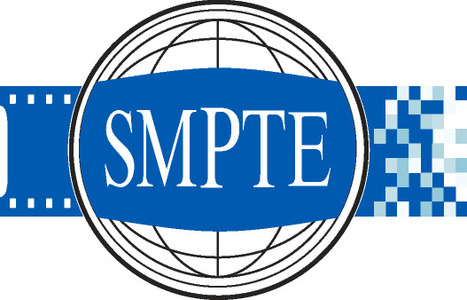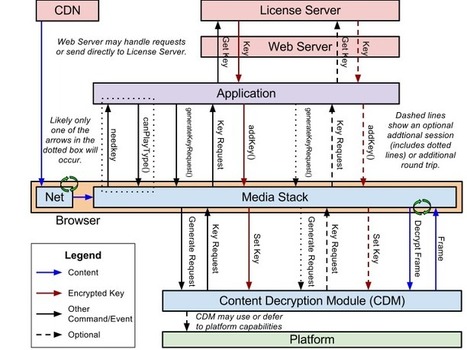 Your new post is loading...
 Your new post is loading...
Encrypted Media Extensions provides an API that enables web applications to interact with content protection systems. Learn how to allow playback of encrypted audio and video.
Converging CAS and DRM", a presentation by David Bouteruche from Nagra.
Online Video French Squad – HangoutSquad #2 February 27th 2014
Digital Rights Management (DRM), at its most basic level, has traditionally been considered as the strategic use of technology to monitor and enforce intellectual property licensing agreements by controlling access to digital content as it is being distributed, protecting it from unauthorized use or downright theft. In the modern world, however, the notion of "broadcasting video" now includes over-the-air terrestrial signal distribution, along with cable, satellite, Internet, and mobile/data network broadcasting of content to, seemingly, an unlimited number of viewing devices. In that universe, the DRM label represents a constantly evolving, often proprietary, network of technologies and protocols used by broadcasters to secure the links of a content chain wherever those links are heading.
Synacor Inc.'s TV Everywhere Platform is serving as the authentication device for almost 40 video distributors of NBCUniversal's coverage of the 2012 Summer Olympics.
Buffalo, N.Y.-based Synacor's TV Everywhere Platform on behalf of the company's pay-TV clients -- a roster that includes No. 3 distributor Dish Network and No. 6 Charter Communications -- will potentially verify tens of millions of CNBC and MSNBC subscribers, so they will be able to access NBCU's 3,500 hours of live streaming Olympic action and attendant content from London.
Civolution, a leading provider of technology and solutions for identifying, managing and monetizing media content, has announced that its NexGuard – Online Media Delivery (OMD) video watermarking technology will run on Windows Azure Media Services. Windows Azure Media Services is a new set of cloud-based media technologies that enable Microsoft Corp.’s customers and partners to create, distribute and manage customized media solutions across all types of devices and platforms. As the newest addition to Civolution’s extensive and award-winning forensic watermarking application suite, NexGuard – OMD enables secure delivery of digital media assets processed through the cloud on Windows Azure. Windows Azure Media Services enables users to upload a video asset to the cloud and configure watermarked output renditions. The watermark insertion is performed in two stages. The first stage, referred to as ‘watermark pre-processing’, is performed once per media asset while transcoding original assets to the desired delivery format. The second step, referred to as ‘watermark smart embedding’ is applied upon streaming by Windows Azure Content Delivery Network (CDN) or third party CDNs. After a media asset is passed through the NexGuard watermark pre-processor, the file is delivered in Smooth Streaming format, to PC, Mac, Xbox and whole host of connected devices like iOS, Android and Connected TV’s which are all capable of supporting smooth streaming format. This format can then be uploaded to a CDN for delivery to the end user and is fully compliant with Microsoft Silverlight. At the CDN level, a transaction identifier is applied by the NexGuard watermark smart embedder, making each delivered stream and copies thereof uniquely traceable. In November 2011 Civolution announced it joined the Akamai NetAlliance partner program as a Digital Media Solution Partner, integrating its NexGuard smart embedder technology with Akamai’s HD CDN.
Pay TV security is an ongoing battle between operators and not just pirates but also individuals who would rather not pay for the service. At the same time, operators have one hand tied behind their backs because unlike in banking, customers are not bothered if someone next door is hacking into their service.This rules out biometric techniques to authenticate users since people are unwilling to have their eyeballs examined to get at their premium content. At IBC this year there was a growing view among operators and security vendors that no single technology can defeat the pirates, especially as services extend to multiple devices in TV Anywhere and OTT deployments. There is also recognition that defences against increasingly sophisticated attacks on encryption keys held in System on a Chip (SoC) components in set-top boxes, home gateways and other devices require stronger defences. For this reason the San Francisco based cryptography company Cryptography Research has gained significant traction among both silicon manufacturers and conditional access (CA) vendors, leading to two significant announcements during the show : - firstly, the company announced that a fourth Pay TV SoC vendor, MStar Semiconductor, was licensing its CryptoFirewall technology in addition to Broadcom, ST Microelectronics and ViXS, which are already on board. - a licensing agreement with CA vendor Verimatrix
|
NAGRA, the Kudelski Group digital TV business and the world’s leading independent provider of content protection and multiscreen television solutions, announced today that its DRM technology, NAGRA MediaAccess Persistent Rights Management (PRM), was approved by the Digital Entertainment Content Ecosystem (DECE) to protect the streaming of premium SD and HD content to open devices for its UltraViolet streaming service.
Linux-based solution is intended to secure media files in Oracle databases throughout workflow cycle. Steve Guilford, president of Database Plugins, LLC, is a man on a mission: over the course of the last few months, Guilford has been informing Streaming Mediaeditors of the progress of his new Oracle 11g-centric media transcoding solution. Recently, Guilford announced completion of a secure transcoding product, called dbObscura, as part of the overall DB Plugins lineup. "You may recall that I stuck my neck out and said I could transcode securely at the data-layer by sourcing from tables in the database," said Guilford in a recent email. "Well, I've figured out how to make FFMPeg seamlessy operate in a secure 'data-layer' environment whereby the media never has to exist as a 'normal' file, in a manner that allows any 'file' based transcoding engine and use it as a secure data-layer transcoder." Guilford currently focuses on Oracle Database 11g, saying that his solution picks up where the Oracle Multimedia framework leaves off, but building on the benefits found within Oracle's secure file infrastructure.
This proposal extends HTMLMediaElement providing APIs to control playback of protected content. The API supports use cases ranging from simple clear key decryption to high value video (given an appropriate user agent implementation). License/key exchange is controlled by the application, facilitating the development of robust playback applications supporting a range of content decryption and protection technologies. This specification does not define a content protection or Digital Rights Management system. Rather, it defines a common API that may be used to discover, select and interact with such systems as well as with simpler content encryption systems. Implementation of Digital Rights Management is not required for compliance with this specification: only the simple clear key system is required to be implemented as a common baseline. The common API supports a simple set of content encryption capabilities, leaving application functions such as authentication and authorization to page authors. This is achieved by requiring content protection system-specific messaging to be mediated by the page rather than assuming out-of-band communication between the encryption system and a license or other server.
Farncombe Technologies, a pay TV technology consultancy based in the UK, has just released a white paper called “The Future of Broadcast Cardless Security.” The white paper incorporates the results of a survey of pay TV operators, content owners, security vendors, and device makers on pay TV security concerns today and in the future. Operators of pay TV (cable, satellite, and telco-TV) networks have put more money and effort into digital content security than any other type of media distributor, certainly more than any digital music or e-book sellers ever have. That’s because the economic incentives of pay TV operators are aligned with those of content owners such as movie studios and TV networks: operators don’t want their signals stolen, while content owners want to minimize unauthorized use of the content that travels over those signals.
During ANGA, Civolution is demonstrating the latest advances in its NexGuard suite of forensic watermarking solutions, which provide both a deterrent against piracy and a forensic analysis tool in case piracy occurs. The product meets requirements for the additional security measures required to offer early-release premium VOD (PVOD). The Hollywood studios are demanding that operators need to integrate transactional watermarking protection into their VOD workflow and network infrastructure to get access to PVOD titles, as it allows for forensic tracking to the source of potential illegal copies.
This proposal extends HTMLMediaElement to enable playback of protected content. The proposed API supports use cases ranging from simple clear key decryption to high value video (given an appropriate user agent implementation). License/key exchange is controlled by the application, facilitating the development of robust playback applications supporting a range of content decryption and protection technologies. No "DRM" is added to the HTML5 specification, and only simple clear key decryption is required as a common baseline.
Bill Rosenblatt has just published a new white paper: The New Technologies for Pay TV Content Security.
The 28-page paper describes the current state of the art of techniques for protecting video content delivered over pay television networks such as cable and satellite. The final section of the paper discusses fingerprinting and watermarking as two techniques that complement encryption as ways of finding unauthorized content “in the wild.”
|
 Your new post is loading...
Your new post is loading...
 Your new post is loading...
Your new post is loading...


















